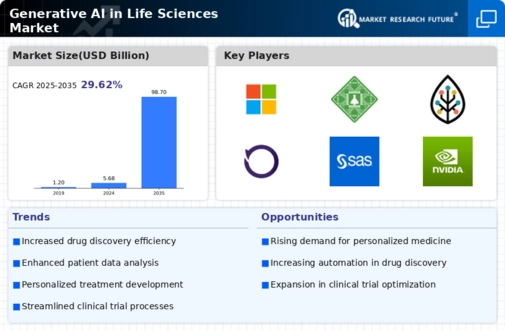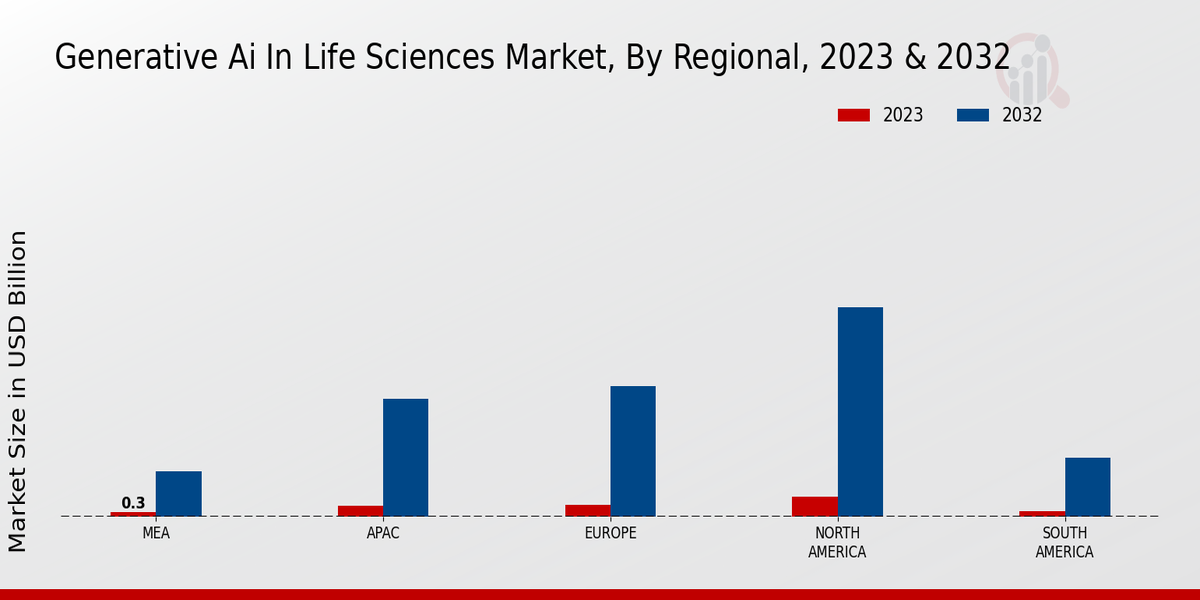Market Growth Projections
The Global Generative AI in Life Sciences Market Industry is projected to experience remarkable growth, with estimates indicating a rise from 5.68 USD Billion in 2024 to 98.7 USD Billion by 2035. This trajectory suggests a robust compound annual growth rate (CAGR) of 29.63% from 2025 to 2035. Such growth is likely driven by the increasing adoption of AI technologies across various applications, including drug discovery, personalized medicine, and clinical trials. The expanding market reflects the growing recognition of generative AI's potential to revolutionize the life sciences sector.
Enhanced Drug Discovery Processes
The Global Generative AI in Life Sciences Market Industry is significantly transforming drug discovery processes. Traditional methods often require extensive time and resources, whereas generative AI accelerates the identification of potential drug candidates through predictive modeling and simulation. By leveraging machine learning algorithms, researchers can analyze chemical compounds and biological data more efficiently. This innovation is expected to contribute to the market's growth, with projections indicating a rise to 98.7 USD Billion by 2035. The increased efficiency in drug discovery could lead to a higher success rate in clinical trials, ultimately benefiting patients.
Integration of AI in Clinical Trials
The integration of generative AI in clinical trials is reshaping the Global Generative AI in Life Sciences Market Industry. AI technologies streamline patient recruitment, optimize trial designs, and enhance data analysis, thereby improving the overall efficiency of clinical research. By utilizing AI-driven insights, researchers can identify suitable candidates more effectively and monitor trial progress in real-time. This trend not only reduces the time required for trials but also increases the likelihood of successful outcomes. As a result, the market is poised for substantial growth, with a projected CAGR of 29.63% from 2025 to 2035.
Rising Demand for Personalized Medicine
The Global Generative AI in Life Sciences Market Industry is experiencing a notable surge in demand for personalized medicine. This trend is driven by advancements in genomics and biotechnology, which enable tailored treatment plans based on individual genetic profiles. Generative AI plays a pivotal role in analyzing vast datasets to identify unique biomarkers and predict patient responses to therapies. As healthcare systems increasingly adopt personalized approaches, the market is projected to reach 5.68 USD Billion in 2024, reflecting a growing recognition of the need for customized healthcare solutions.
Increased Investment in Healthcare Technology
The Global Generative AI in Life Sciences Market Industry is witnessing a surge in investment as stakeholders recognize the potential of AI technologies in healthcare. Governments and private entities are allocating substantial funds to support research and development initiatives aimed at integrating generative AI into life sciences. This influx of capital is expected to drive innovation, enhance operational efficiencies, and improve patient outcomes. As investment continues to rise, the market is likely to expand significantly, reflecting the growing commitment to harnessing AI for transformative healthcare solutions.
Growing Regulatory Support for AI Applications
The Global Generative AI in Life Sciences Market Industry benefits from increasing regulatory support for AI applications in healthcare. Regulatory bodies are establishing frameworks that facilitate the safe and effective use of AI technologies in drug development, diagnostics, and patient care. This supportive environment encourages innovation and fosters collaboration between technology developers and life sciences organizations. As regulations evolve to accommodate AI advancements, the market is expected to thrive, with stakeholders more willing to adopt generative AI solutions to enhance their operations.













